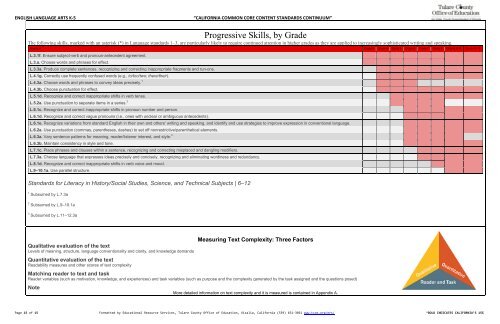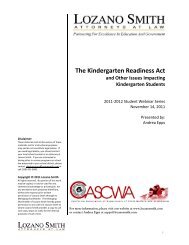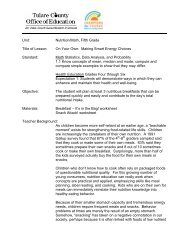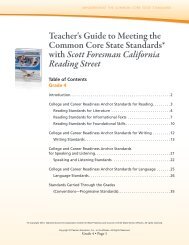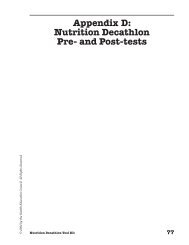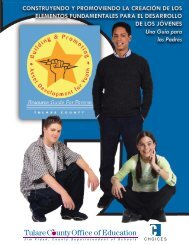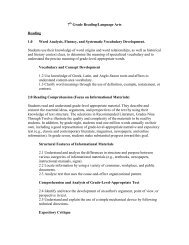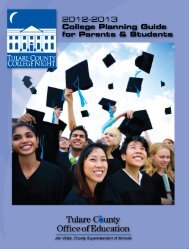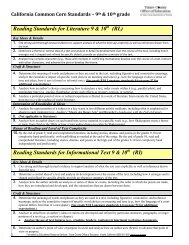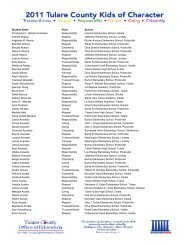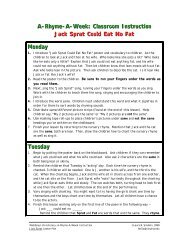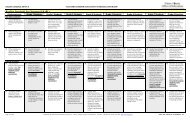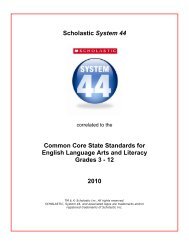CCCS K-5 ELA Continuum - Tulare County Office of Education
CCCS K-5 ELA Continuum - Tulare County Office of Education
CCCS K-5 ELA Continuum - Tulare County Office of Education
- No tags were found...
Create successful ePaper yourself
Turn your PDF publications into a flip-book with our unique Google optimized e-Paper software.
ENGLISH LANGUAGE ARTS K‐5 “CALIFORNIA COMMON CORE CONTENT STANDARDS CONTINUUM”Progressive Skills, by GradeThe following skills, marked with an asterisk (*) in Language standards 1–3, are particularly likely to require continued attention in higher grades as they are applied to increasingly sophisticated writing and speaking.Standard Grade 3 Grade 4 Grade 5 Grade 6 Grade 7 Grade 8 Grades 9-10 Grade 11-12L.3.1f. Ensure subject-verb and pronoun-antecedent agreement.L.3.a. Choose words and phrases for effect.L.3.3a. Produce complete sentences, recognizing and correcting inappropriate fragments and run-ons.L.4.1g. Correctly use frequently confused words (e.g., to/too/two; there/their).L.4.3a. Choose words and phrases to convey ideas precisely. 1L.4.3b. Choose punctuation for effect.L.5.1d. Recognize and correct inappropriate shifts in verb tense.L.5.2a. Use punctuation to separate items in a series. 2L.6.1c. Recognize and correct inappropriate shifts in pronoun number and person.L.6.1d. Recognize and correct vague pronouns (i.e., ones with unclear or ambiguous antecedents).L.6.1e. Recognize variations from standard English in their own and others’ writing and speaking, and identify and use strategies to improve expression in conventional language.L.6.2a. Use punctuation (commas, parentheses, dashes) to set <strong>of</strong>f nonrestrictive/parenthetical elements.L.6.3a. Vary sentence patterns for meaning, reader/listener interest, and style. 3L.6.3b. Maintain consistency in style and tone.L.7.1c. Place phrases and clauses within a sentence, recognizing and correcting misplaced and dangling modifiers.L.7.3a. Choose language that expresses ideas precisely and concisely, recognizing and eliminating wordiness and redundancy.L.8.1d. Recognize and correct inappropriate shifts in verb voice and mood.L.9–10.1a. Use parallel structure.Standards for Literacy in History/Social Studies, Science, and Technical Subjects | 6–121 Subsumed by L.7.3a2 Subsumed by L.9–10.1a3 Subsumed by L.11–12.3aQualitative evaluation <strong>of</strong> the textLevels <strong>of</strong> meaning, structure, language conventionality and clarity, and knowledge demandsQuantitative evaluation <strong>of</strong> the textReadability measures and other scores <strong>of</strong> text complexityMeasuring Text Complexity: Three FactorsMatching reader to text and taskReader variables (such as motivation, knowledge, and experiences) and task variables (such as purpose and the complexity generated by the task assigned and the questions posed)NoteMore detailed information on text complexity and it is measured is contained in Appendix A.Page 15 <strong>of</strong> 15 Formatted by <strong>Education</strong>al Resource Services, <strong>Tulare</strong> <strong>County</strong> <strong>Office</strong> <strong>of</strong> <strong>Education</strong>, Visalia, California (559) 651‐3031 www.tcoe.org/ers/ *BOLD INDICATES CALIFORNIA’S 15%


